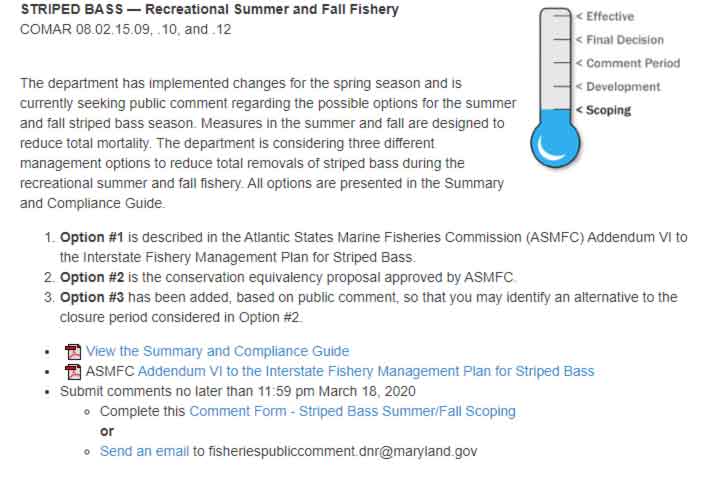The Maryland DNR has just posted three options for the summer fishery and we need recreational anglers to give input NOW! Anglers, during the last comment period the DNR received a few hundred emails. That’s it. The recreational angling community quite frankly fell down on the public comment job and far too few people took the time to let their voices be heard. Thus, the spring catch and release fishing is closed.

Now, the DNR has opened up the public comment period for the summer/fall fishery. They are giving us three options:
Option Number One (which the ASMFC has recommended) lets recreational and charter boat anglers keep one fish per day at 18-inches from May 16 through December 15.
Option Number Two lets recreational anglers keep one fish per day at 19-inches with the season ending December 10, with a two-week closure from August 16 through August 31, but allows charter boats to keep two fish per day.
Option Number Three is essentially the same as Option Two, but additionally allows for some changes in when the two-week closure takes place (at some point between July 16 and August 31).
Remember: commercial interests are taking a 1.8-percent reduction in quota this year, while recreationals are being hit with a reduction of over 20-percent. Evidently that wasn’t good enough—now recreational anglers will also have to give up two weeks of prime summer fishing, this time so that the charter fleet can keep two fish a day as opposed to one.
Despite talk of “reducing discard mortality” and “expanding protection” do not think for one moment that any of this is being proposed for the good of the fishery. Cutting off April preseason catch-and-release fishing to “save” thousands of fish—the figure used was 10,000 C & R fish per day—that never would have been caught (much less died) buried that argument six feet under. No, options two and three exist for only one reason: so that charter boats can catch two fish per person per day, while recreational boats get one fish, the summer closure, and an earlier end to the season. The total estimated number of stripers being removed from the Bay is calculated to be approximately equal among these options.
For this reason, we believe that recreational anglers should give their public comment in favor of Option One. We also believe that each and every recreational angler should include in their comments a request for the state to immediately take action to scientifically determine seasonal catch and release mortality, so that in the future these decisions can be supported with data. When this issue arose with cod, it took a single study—utilizing modern technology and costing only $200,000—to get solid science on all the variables and factors affecting release mortality, and establish actual death rates for released fish. It is utterly shameful that we don’t have this sort of data for striped bass and instead have been using demonstrably unscientific, partial, and dated studies in the management of this fishery.
According to the latest data from Southwick and Associates, in the state of Maryland recreational striped bass fishing accounts for 5.5 times the number of jobs and 12.4 times more wages than commercial striped bass fishing, and it generates 14.6 times more GDP. Ninety-seven percent of the economic value of this fishery is generated by the recreational sector. Yet we recs have virtually zero say in what happens. If you read this far, please click the link above and make your comment right now.